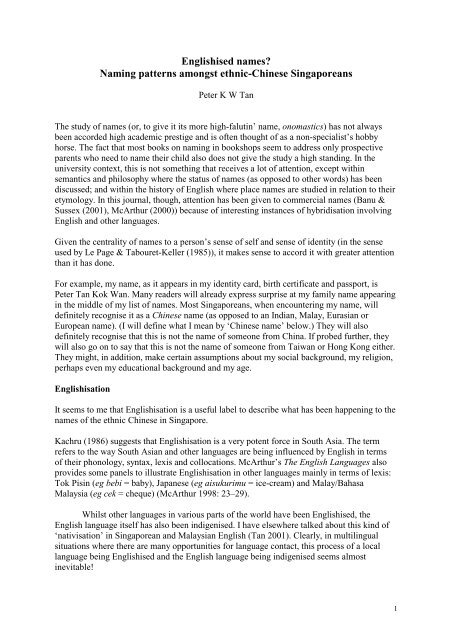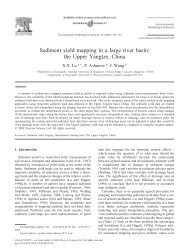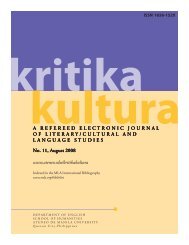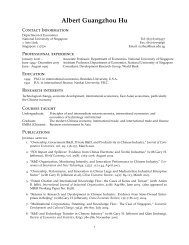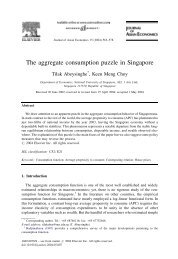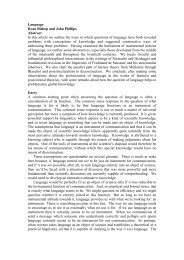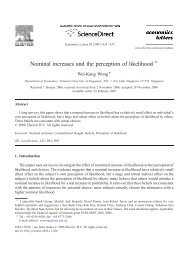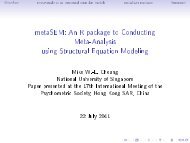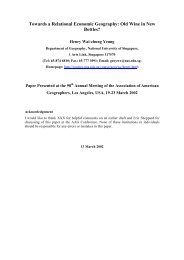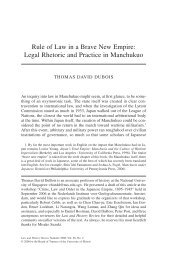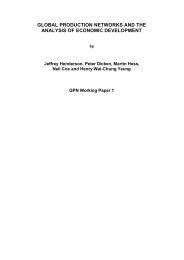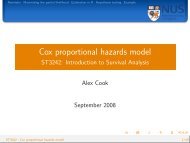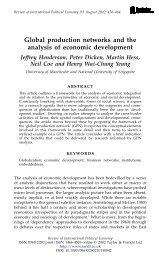Naming patterns amongst ethnic-Chinese Singaporeans - NUS Home
Naming patterns amongst ethnic-Chinese Singaporeans - NUS Home
Naming patterns amongst ethnic-Chinese Singaporeans - NUS Home
Create successful ePaper yourself
Turn your PDF publications into a flip-book with our unique Google optimized e-Paper software.
Englishised names?<br />
<strong>Naming</strong> <strong>patterns</strong> <strong>amongst</strong> <strong>ethnic</strong>-<strong>Chinese</strong> <strong>Singaporeans</strong><br />
Peter K W Tan<br />
The study of names (or, to give it its more high-falutin’ name, onomastics) has not always<br />
been accorded high academic prestige and is often thought of as a non-specialist’s hobby<br />
horse. The fact that most books on naming in bookshops seem to address only prospective<br />
parents who need to name their child also does not give the study a high standing. In the<br />
university context, this is not something that receives a lot of attention, except within<br />
semantics and philosophy where the status of names (as opposed to other words) has been<br />
discussed; and within the history of English where place names are studied in relation to their<br />
etymology. In this journal, though, attention has been given to commercial names (Banu &<br />
Sussex (2001), McArthur (2000)) because of interesting instances of hybridisation involving<br />
English and other languages.<br />
Given the centrality of names to a person’s sense of self and sense of identity (in the sense<br />
used by Le Page & Tabouret-Keller (1985)), it makes sense to accord it with greater attention<br />
than it has done.<br />
For example, my name, as it appears in my identity card, birth certificate and passport, is<br />
Peter Tan Kok Wan. Many readers will already express surprise at my family name appearing<br />
in the middle of my list of names. Most <strong>Singaporeans</strong>, when encountering my name, will<br />
definitely recognise it as a <strong>Chinese</strong> name (as opposed to an Indian, Malay, Eurasian or<br />
European name). (I will define what I mean by ‘<strong>Chinese</strong> name’ below.) They will also<br />
definitely recognise that this is not the name of someone from China. If probed further, they<br />
will also go on to say that this is not the name of someone from Taiwan or Hong Kong either.<br />
They might, in addition, make certain assumptions about my social background, my religion,<br />
perhaps even my educational background and my age.<br />
Englishisation<br />
It seems to me that Englishisation is a useful label to describe what has been happening to the<br />
names of the <strong>ethnic</strong> <strong>Chinese</strong> in Singapore.<br />
Kachru (1986) suggests that Englishisation is a very potent force in South Asia. The term<br />
refers to the way South Asian and other languages are being influenced by English in terms<br />
of their phonology, syntax, lexis and collocations. McArthur’s The English Languages also<br />
provides some panels to illustrate Englishisation in other languages mainly in terms of lexis:<br />
Tok Pisin (eg bebi = baby), Japanese (eg aisukurimu = ice-cream) and Malay/Bahasa<br />
Malaysia (eg cek = cheque) (McArthur 1998: 23–29).<br />
Whilst other languages in various parts of the world have been Englishised, the<br />
English language itself has also been indigenised. I have elsewhere talked about this kind of<br />
‘nativisation’ in Singaporean and Malaysian English (Tan 2001). Clearly, in multilingual<br />
situations where there are many opportunities for language contact, this process of a local<br />
language being Englishised and the English language being indigenised seems almost<br />
inevitable!<br />
1
A little aside here: one might ask, why Englishisation rather than Anglicisation which<br />
is a more established term to be found in dictionaries? The Bank of English corpus of English<br />
texts (or the Collins COBUILD Corpus) reveals 24 occurrences of the items anglicise<br />
/anglicize and anglicisation/ anglicization in their various inflected forms; and no<br />
occurrences of englishise/ englishize or englishisation/ englishization. Although the majority<br />
of the 24 occurrences referred to language and in particular names (eg ‘The last name is an<br />
anglicized version of Nguyen – the pronunciation is similar’), there were a number of<br />
occurrences where the term referred to other things like food (eg ‘It was an unabashedly<br />
Anglicised curry, of grated apple, sultanas, …’). I continue to use Kachru’s term Englishise<br />
to make clear that the reference is linguistic, rather than general or cultural with reference to<br />
the people of England.<br />
A strong motivation for Englishisation is the extension of both the resources available in a<br />
given language and its functional range.<br />
It seems to me that one reason for the linguistic ‘openness’ toward English on the part<br />
of the Hindi enthusiasts is that the process of Englishization unconsciously operates as<br />
a linguistic device to ‘equip’ the Hindi language with the functional range of English,<br />
which, consequently, might lead toward an ‘upward’ move of Hindi in the hierarchy<br />
of linguistic roles.<br />
(Kachru 1986: 149)<br />
Englishisation is also closely associated with the notion of modernisation, new learning and<br />
new technologies. Sometimes, Englishisation occurs also to reflect a cultural shift to reflect a<br />
re-negotiation of cultural values and relations. We can see this, for example, in some<br />
instances where English loanwords are used even when there was no initial lexical gap. We<br />
can take the example of the use of English-based first- and second-person pronouns (you, I)<br />
in colloquial Malay. Here, for example, is a message posted in the Malaysian UFO Network<br />
Mailing List.<br />
Now I think I understand... I nak tanya pada you Fakhroul, so bagi<br />
you 1% daripada 99% makhluk UFO adalah MUSLIM..???<br />
Now I think I understand … I want to ask you, Fakhroul, so for you 1% out of the<br />
99% of UFO creatures are MUSLIM..?? (my translation and my emphases)<br />
Muz (4 Dec 1998)<br />
The first sentence is in English. Thereafter, the writer switches to Malay where we see the use<br />
of I and you. Of course there are first- and second-person pronouns in Malay: saya, aku and<br />
the royal beta for the first-person; awak, kamu, anda, engkau and kau for the second-person;<br />
and in many situations, even these are avoided and an honorific or a third-person reference is<br />
used. In the context of a complex system of pronouns depending on the relationship between<br />
the sender and the receiver, is it any surprise that some have opted for the more ‘democratic’<br />
English pronouns instead?<br />
Names are surely not impervious to the process of Englishisation too. In fact, names that we<br />
think of as quintessentially English are frequently derived from other sources. One important<br />
source is (Norman) French following the Norman conquest of Britain in 1066 (Alan,<br />
Bernard, Geoffrey, Henry, Constance, Emma, Yvonne). Another is Hebrew following the<br />
Reformation and the preference of Protestants for using the Bible as a source of names<br />
2
(Benjamin, Daniel, David, Michael, Deborah, Rachel, Rebecca, Sarah). There are names that<br />
can be traced back to Old English elements (Alfred, Edgar, Edith, Edward) but these<br />
constitute only a relatively small proportion of available English first names. (For further<br />
examples, see Dunkling (1993: 42–45).)<br />
The <strong>Chinese</strong> <strong>Naming</strong> Conventions<br />
The <strong>Chinese</strong> naming tradition is very well established and I shall only discuss the main<br />
points. The <strong>Chinese</strong> personal name is made up of two components. The first element is the<br />
surname or xing, which is usually monosyllabic (and therefore written with one character), as<br />
in Chen, He, Li or Wang, although there are a few disyllabic ones like Situ. Unlike in some<br />
other traditions, such as the Anglo-American one, the range of surnames is much smaller, so<br />
that about 87% of the Han <strong>Chinese</strong> people (the main <strong>ethnic</strong> group in China) use the most<br />
common 100 surnames (Louie 1998: 35). (Note that in this section, I use the well-established<br />
pinyin system of Romanisation based on the Mandarin <strong>Chinese</strong> pronunciation.)<br />
The next element is the given name or ming or mingzi. This is usually disyllabic (written with<br />
two characters) although it can be monosyllabic (written with one character) as well. Where<br />
the given name is disyllabic, one of the syllables (usually the first) could be the ‘generation<br />
name’ which would be shared with the person’s relatives of the same sex of the same<br />
generation on the male line.<br />
For example, my <strong>Chinese</strong> name based on pinyin is Chen Guowan. Chen would be my<br />
surname; and Guowan my given name. The Guo element in my given name is my generation<br />
name which I share with my brother and all my male cousins on my father’s side of the<br />
family. Table 1 gives some examples of well-known <strong>Chinese</strong> names, including the normal<br />
way they are represented in English texts: the philosophers Confucius and Mencius; the<br />
<strong>Chinese</strong> Nationalist leader Chiang Kai-shek; the Kuomintang leader Sun Yat-sen; the founder<br />
of the People’s Republic of China Mao Zedong; the Hong Kong film magnate Run Run Shaw;<br />
the former Singaporean Prime Minister Lee Kuan Yew; and the Malaysian actress and former<br />
Bond girl Michelle Yeo.<br />
Surname Given Name Usual English Version<br />
Jiang Jieshi Chiang Kai-shek<br />
Kong Fuzi Confucius<br />
Li Guangyao (Harry) Lee Kuan Yew<br />
Mao Zedong Mao Zedong or Mao Tse-tung<br />
Meng Zi Mencius<br />
Shao Yifu (Sir) Run Run Shaw<br />
Sun Zhongshan or Wen Sun Yat-sen<br />
Yang Ziqiong Michelle Yeo<br />
TABLE 1. Some Well-known <strong>Chinese</strong> Names<br />
Two points about the system which contrasts with the Anglo-American system need to be<br />
pointed out. Firstly, the surname always comes first. As Louie puts it,<br />
Since early on in their civilization, the <strong>Chinese</strong> have placed the surname first<br />
in a name, which seems to emphasize that the family comes first in an individual’s<br />
3
identity. Other Asians, such as the Japanese, Koreans, and Vietnamese, also place the<br />
surname first. In Europe, Hungarians and Rumanians follow this name order as well.<br />
(Louie 1998: 51)<br />
Because of this differences in ordering of names, I will use the terms ‘surname’ and ‘given<br />
name’ as opposed to the more familiar terms ‘last name’ and ‘first name’ or ‘forename’.<br />
Secondly, all the characters of <strong>Chinese</strong> are technically available as <strong>Chinese</strong>-based given<br />
names. There are no words especially reserved for names as there are in English (like<br />
Matthew or Barbara). The semantic transparency of <strong>Chinese</strong>-based given names does mean<br />
that meaning must feature highly in the choice of any <strong>Chinese</strong>-based given name. This<br />
contrasts to the situation in English: how many of us know offhand that Matthew means ‘gift<br />
of God’ or that Barbara means ‘foreign woman’ (Hanks & Hodges 1990: 230, 35)? Hence,<br />
there is a higher reliance on other factors for the choice of an English-based given name, such<br />
as sounds or associations. This is not to say that the <strong>Chinese</strong> do not rely on sounds or<br />
associations or that there are no character that is more likely to be picked as <strong>Chinese</strong>-based<br />
given names. Of course there are. Only meaning must feature more highly in <strong>Chinese</strong>-based<br />
given names.<br />
Traditional <strong>Chinese</strong> <strong>Naming</strong> Practices beyond China<br />
The discussion above might begin to suggest that the naming practices of all <strong>ethnic</strong> <strong>Chinese</strong><br />
are uniform. This is certainly not the case. Even within mainland China, there are differences<br />
in the distribution of surnames between the north and the south. The great surnames in the<br />
north are Li, Wang, Zhang and Liu; whereas in the south they are Chen (Chan, Tan), Zhao<br />
(Chew, Yeo), Huang (Wong, Ooi, Ng), Lin (Lam, Lim) and Wu (Ng, Goh) (Louie 1998: 35). I<br />
have included some alternative versions of the surnames in parentheses to indicate typical<br />
southern pronunciations. This is significant because most <strong>Chinese</strong> immigrants to other parts<br />
of the world come from southern China. Tsai’s (2000b) study (see below) confirms the<br />
prevalence of southern surnames in Taiwan: the top three are Chen, Lin and Huang. And of<br />
course, the present Taiwanese President is Chen Shui-bian.<br />
There have been some studies involving the naming practices of the <strong>ethnic</strong> <strong>Chinese</strong> in Hong<br />
Kong among bilinguals (Li 1997), in the USA (Louie 1998) and in Taiwan (Tsai 2000a,<br />
2000b). Jones (1989, 1997) studied the naming practices <strong>amongst</strong> the <strong>Chinese</strong> in what was<br />
then Malaya (now Malaysia). They involved very different methodology. Li’s work is based<br />
on questionnaires sent out in the 1990s as well as press cuttings in the same period. Louie’s<br />
work covers a wider time span and makes use of a range of ethnographic methods involving<br />
press reports, official documents, gravestones. Tsai’s work is based on about 200,000 names<br />
who passed the Taiwanese college entrance examinations in 1994–97. Finally, Jones’s study<br />
is apparently based on his work in the Immigration Department headquarters in the northern<br />
Malayan island of Penang in the 1950s.<br />
Whereas Li’s study includes unofficial names, the other studies focus only on official names.<br />
Also very important from our point of view, Tsai’s study is based on the names in their<br />
<strong>Chinese</strong> form (ie using <strong>Chinese</strong> characters) whereas the other studies give attention to the<br />
Romanised forms too.<br />
Finally, the countries from which the names are taken represent very different contexts from<br />
the point of view of the position of the English language. Using traditional terms, we could<br />
4
label the USA as an English-as-mother-tongue (EMT) country, whereas Malaysia and Hong<br />
Kong are English-as-a-second-language (ESL) countries and Taiwan is an English-as-aforeign-language<br />
(EFL) country. Not surprisingly, the notion of Englishisation is touched<br />
upon in the Hong Kong and American contexts, and to a certain extent in the Malayan<br />
context.<br />
Jones’s work is also relevant from the point of view of Singapore because in the 1950s<br />
Penang, like Singapore, was governed by the British and they are only some 400 miles apart.<br />
Also like Singapore, it was an island where most of the inhabitants were <strong>ethnic</strong> <strong>Chinese</strong>, the<br />
majority of whom spoke Hokkien <strong>Chinese</strong> (a southern <strong>Chinese</strong> language) with an Englishspeaking<br />
élite. (For details, see Heidhues (2000: 157–160).) What is especially interesting is<br />
that the names and forms described are conform, almost completely, to those found in the<br />
Nanyang University (1960) data mentioned below.<br />
<strong>Chinese</strong> Names in Singapore<br />
In the examples of Singaporean names that follow, I shall use three sources:<br />
(1) Nanyang University (1960) – this is the list of the 1960 graduates of Nanyang University<br />
in 1960 (I use the abbreviation NU for names from this source);<br />
(2) University of Singapore (1968) – this is the list of the graduands of the University of<br />
Singapore in 1968 (abbreviation: US); and<br />
(3) National University of Singapore (2000) – this is the list of the graduands of the National<br />
University of Singapore in 2000 (abbreviation: <strong>NUS</strong>).<br />
I should also add that Nanyang University was a <strong>Chinese</strong>-medium university that eventually<br />
merged with the University of Singapore, an English-medium institution, to become the<br />
National University of Singapore, which is English-medium except for a few programmes.<br />
These name records have been used because they have been roughly sorted out according to<br />
age and definitely sorted out according to sex (and a title, usually ‘Miss’, is appended to<br />
female names). The name records from the Registry of Births in Singapore, unlike in some<br />
other places, is not open to public inspection. It will also be obvious at this stage that I will<br />
only focus on official names.<br />
The NU and US data provide us with the names typical of older <strong>Singaporeans</strong> today whereas<br />
the <strong>NUS</strong> data provide us with names of those in their 20s. The NU and the US data contrast<br />
because the typical Nanyang University student would be fluent in <strong>Chinese</strong>, including<br />
Mandarin <strong>Chinese</strong>, but not necessarily be fluent in English. Not surprisingly the NU names<br />
conform more closely to the traditional <strong>Chinese</strong> naming conventions mentioned above. The<br />
University of Singapore students, on the other hand, would have gone through Englishmedium<br />
education in school; <strong>ethnic</strong> <strong>Chinese</strong> students will speak some <strong>Chinese</strong> languages,<br />
though not necessarily Mandarin <strong>Chinese</strong>, and literacy in <strong>Chinese</strong> cannot be assumed.<br />
It will also be necessary for me to clarify my terminology at this stage. I will use the term<br />
‘<strong>Chinese</strong> name’ to mean names of the <strong>ethnic</strong> <strong>Chinese</strong>, conforming to a greater or lesser extent<br />
to the traditional <strong>Chinese</strong> convention of personal names. I will use the term ‘<strong>Chinese</strong>-based<br />
name’ to refer to names that are derived from <strong>Chinese</strong> words and characters. ‘English-based<br />
name’ refers to a name derived from given names of English speakers or names based on the<br />
English language, but not from <strong>Chinese</strong> characters. In the lists that I consulted, English-based<br />
names generally appear before <strong>Chinese</strong> surnames whereas <strong>Chinese</strong>-based names generally<br />
appear after <strong>Chinese</strong> surnames.<br />
5
The Exponents of the Englishisation of <strong>Chinese</strong> Names<br />
So how then can we say that <strong>Chinese</strong> Names of <strong>Singaporeans</strong> have been Englishised and<br />
what has this got to say about the <strong>Chinese</strong> in Singapore?<br />
1. Romanisation<br />
It is important to point out that it is the version of the name spelt out in the Roman alphabet<br />
that constitutes the official name of individuals in Singapore. This contrasts to the situation in<br />
mainland China where a person’s official name is the one written in <strong>Chinese</strong> characters. The<br />
Romanised name is therefore ‘fixed’ and an individual is not at liberty to alter the spelling of<br />
his or her name. In such a context, the individual would claim ownership of the name in its<br />
representation in terms of letters of the alphabet. In the same way, an Ann would say that<br />
‘Anne’ is not her name; a Geoffrey would say that ‘Jeffrey’ is not his name. In the same way,<br />
the pinyin version of my name Chen Guowan looks totally alien to me.<br />
Given that the Roman alphabet in Singapore is primarily associated with the English<br />
language, Romanisation can be seen as Englishisation. This is emphasised in the way the<br />
names are laid out in Nanyang University (1960): see Table 2.<br />
TABLE 2: Extract from the Nanyang University List of Graduates, 1960.<br />
What is particularly interesting to me is the fact that all names here are listed in two formats,<br />
labelled ‘<strong>Chinese</strong>’ (and in <strong>Chinese</strong> characters zhong wen, ‘<strong>Chinese</strong> language’) and ‘English’<br />
(ying wen, ‘English language’). The version in <strong>Chinese</strong> characters is considered the real<br />
<strong>Chinese</strong> version of the name and the Romanised version is considered an English version, or,<br />
more accurately, an Englishised version.<br />
Another feature to point out is that most of the most of the names have been Romanised not<br />
based on Mandarin <strong>Chinese</strong> pronunciation, but on pronunciation in southern <strong>Chinese</strong><br />
languages like Hokkien <strong>Chinese</strong> or Cantonese <strong>Chinese</strong>. In pinyin, Ong Chooi Koon becomes<br />
Wang Suijun. But even in pinyin, the tone information (<strong>Chinese</strong> is a tonal language) is often<br />
omitted, although it can be included in the form of diacritics or numbers (eg Wang2<br />
Sui1jun1). The southern <strong>Chinese</strong> languages, lacking a systematic convention of<br />
Romanisation, cannot include tone information, so that these are lost in the process of<br />
Englishisation.<br />
6
2. Romanisation based on English<br />
It is not the mere fact of Romanisation alone that we can say is an exponent of Englishisation.<br />
It is also fairly obvious that peculiarly English orthographic conventions and English<br />
orthography-phonology correspondences have also been employed.<br />
1 Dieu Eng Keong (US)<br />
2 Law Cheng Por (NU)<br />
3 Lee Yoke Cum (<strong>NUS</strong>)<br />
4 Regina Loo Yuet Lye (<strong>NUS</strong>)<br />
5 Robin Chee Rhern Whee (<strong>NUS</strong>)<br />
TABLE 3. Names Illustrating English-style Romanisation<br />
Examples of English orthographic conventions employed are<br />
• silent letters, like<br />
o silent in Rhern Whee (5)<br />
o silent in Lye (4)<br />
o silent after vowel letters in Por (2) and Rhern (4) – this assumes a nonrhotic<br />
pronunciation of English; the affects the quality of the preceding<br />
vowel where produces /O/, not /o/; and produces /@/, not /E/.<br />
• letter doubling, like<br />
o in Loo (4)<br />
o in Lee (3) and Chee (5)<br />
Examples of English orthography-phonology correspondences are<br />
• the digraph given the value of /tS/ in Cheng (2) – as in Church<br />
• the digraph given the value of /O/ in Law (2) – as in Jaw<br />
• the digraph given the value of /u/ in Dieu (1) – as in neutral<br />
• the letter given the value of /I/ in Eng (1) and Cheng (2) – as in England<br />
• the letter given the value of /V/ in Cum (3) – as in mum<br />
This contrasts to, say, the Indonesian situation, where Romanisation was in the direction of<br />
Dutch conventions, so that Loo would have been Loe and Chee would have been Tjie. (There<br />
is a discussion of the Indonesian spelling of <strong>Chinese</strong> names in Jones (1997: 64–65).) This<br />
also contrasts with other standardised systems, such as the Hanyu Pinyin system (mentioned<br />
above) and the Wade-Giles system for Mandarin.<br />
3. English-based given names<br />
For most, though, the most obvious feature of Englishisation in <strong>Chinese</strong> names in Singapore<br />
is the presence of English-based given names. The former Singaporean Prime Minister Lee<br />
Kuan Yew commented on naming trends <strong>amongst</strong> <strong>Chinese</strong> <strong>Singaporeans</strong> in September 1984<br />
which was reproduced in The Straits Times:<br />
… over one-third of <strong>Chinese</strong> parents registered additional Western or Christian<br />
personal names for their sons and daughters.<br />
Twenty years ago (1964), only one-fifteenth registered Christian personal<br />
names. Western influence has increased by five times.<br />
(The Straits Times, 22 September 1984)<br />
7
We might doubt whether ‘Western influence’ is measurable in the way described, but clearly<br />
the change is significant. The figures would probably be higher today. The <strong>NUS</strong> data of<br />
graduands, mainly born in the late 70s, have a proportion of names with English-based given<br />
names comparable to the figures given by Lee. By contrast, however, the NU data only reveal<br />
two names with English-based given names. Table 4 gives examples of names with Englishbased<br />
given names.<br />
1. Lily Shaw (NU)<br />
2. Nellie Tay (NU)<br />
3. Ronnie Neo Choon Kiat (SU)<br />
4. Victoria Hsui (SU)<br />
5. Mabel Lee Siew Peng (<strong>NUS</strong>)<br />
6. Mark Lee Tze Ming (<strong>NUS</strong>)<br />
7. Paul Leonard Yeoh (<strong>NUS</strong>)<br />
8. Wendy Praise Cheng Kai Huey (<strong>NUS</strong>)<br />
9. Maximilian Mark Cheong Seng Loong (<strong>NUS</strong>)<br />
10. Eileen Goh (<strong>NUS</strong>)<br />
11. Michelle Loke (<strong>NUS</strong>)<br />
TABLE 4. Names Illustrating English-based Given Names<br />
Also significant is the number of names that include English-based middle names or second<br />
given names (names 7–9). There can be no doubt that this can be linked to the fact that the<br />
huge majority of Anglo-American names include middle names.<br />
4. The abandonment of <strong>Chinese</strong>-based given names<br />
As a result of the inclusion of English-based given names, the <strong>Chinese</strong>-based given names<br />
might be considered redundant. Names 1, 2, 4, 7, 10 and 11 in Table 4 above illustrate names<br />
in this format. It also needs to be added that I would expect people with names 5 and 6 would<br />
introduce themselves as ‘Mabel Lee’ and ‘Mark Lee’ in contexts where given names and<br />
surnames were required; and as ‘Mabel’ and ‘Mark’ where only given names were required.<br />
In other words, <strong>Chinese</strong>-based given names do not seem to typically play a significant role<br />
where individuals also have English-based given names.<br />
Every term when I take tutorials at university, there would also be students who, on my<br />
official list, have only <strong>Chinese</strong>-based given names but I would be asked to address them by<br />
some English-based given names. Non-official English-based given names can also eclipse<br />
official <strong>Chinese</strong>-based given names.<br />
5. Name order<br />
The fact that three-quarters of the population of Singapore is <strong>ethnic</strong> <strong>Chinese</strong> means that the<br />
normal <strong>Chinese</strong> name order – with the surname first – can be preserved without causing<br />
confusion in the way they might do in other countries: for example, Ong is the surname of<br />
Ong Chooi Koon (Table 2). Outside of Singapore, though, the <strong>ethnic</strong> <strong>Chinese</strong> frequently find<br />
it easier to put the surname last, as in the case of the cellist Yo-yo Ma, for example.<br />
The introduction of English-based given names means that two systems are at play: the<br />
Anglo-American system of given name(s) before the surname and the <strong>Chinese</strong> system of<br />
given name after the surname. The result is therefore a hybridised system.<br />
8
The university lists might, however, suggest greater uniformity than is the case though. The<br />
university lists have been standardised to conform to the format <br />
+ + , as in ‘Mabel Lee Siew Peng’ (from Table 4<br />
above). However, the name order can be standardised differently; in alphabetised lists, for<br />
example, it is normal for names to conform to the format + + . Names 6 and 7 in Table 4 would then appear as:<br />
Lee Tze Ming, Mark<br />
Yeoh, Paul Leonard<br />
The commas might, additionally, be omitted and the names would appear to conform to the<br />
traditional <strong>Chinese</strong> order.<br />
Interestingly though, if any initials are used, the surnames would normally go to the end, as in<br />
Mark T. M. Lee. This applies also to names that do not contain English-based given names;<br />
‘Lee Yoke Cum’ (Table 3) could style herself as Y. C. Lee. (The way I use my name<br />
professionally also conforms to this format.) In this respect, therefore, the name order can be<br />
considered Englishised.<br />
Other Influences: Mandarinisation and Pinyinisation<br />
Clearly, Englishisation is not the only phenomenon occurring in <strong>Chinese</strong> names in Singapore.<br />
The Singapore government is also keen to promote Mandarin <strong>Chinese</strong> (as opposed to other<br />
<strong>Chinese</strong> languages) as the <strong>Chinese</strong> language to unify the <strong>Chinese</strong> people; in recent years,<br />
Mandarin <strong>Chinese</strong> has been promoted to win over English-speaking <strong>Chinese</strong> individuals too.<br />
At one stage also, <strong>ethnic</strong> <strong>Chinese</strong> pupils in schools were to be known only by the Mandarin<br />
<strong>Chinese</strong> versions of their surnames and <strong>Chinese</strong>-based given names, and Romanised in the<br />
pinyin system. Jernudd (1994) discusses this in the context of linguistic rights.<br />
I mentioned earlier that the <strong>Chinese</strong> in Singapore are generally from southern <strong>Chinese</strong> stock<br />
and spoke non-Mandarin <strong>Chinese</strong> languages, as reflected in the traditional Romanisations of<br />
their names. Clearly, Mandarinisation and Pinyinisation are now very much in force. Here are<br />
some examples from the <strong>NUS</strong> data.<br />
1. Chen Yanfeng<br />
2. Mark Lee Tze Ming<br />
3. Lim Aizhen<br />
4. Jacqueline Lim Su Tsi<br />
5. Ng Zhi-Yuan<br />
TABLE 5. Mandarinised Names<br />
Of the names in Table 5, only the first one conforms completely to pinyin Romanisation.<br />
Names 3 and 5 represent partial pinyinisation because the surnames still represent non-<br />
Mandarin <strong>Chinese</strong> surnames. The pinyin system is distinct in its use of letters and digraphs<br />
like , , , and . Names 2 and 4 also represent Mandarinisation but the<br />
spelling seems to have been influenced by the earlier Wade-Giles Romanisation which,<br />
among other things, used digraphs like , and .<br />
9
The use of pinyin is not without its problems, and generally the other <strong>ethnic</strong> groups in<br />
Singapore, who generally do not know Mandarin <strong>Chinese</strong>, find the representation employing<br />
, , etc. alienating. Recently, the name of a shopping centre and market have reverted<br />
to its pre-pinyin name: Tekka (from Hokkien <strong>Chinese</strong> tek ‘bamboo’, kha ‘foot’). For many<br />
years, the sign announced the building as the ‘Zhujiao Centre’ (and zhu and jiao are<br />
pinyinised Mandarin for tek and kha respectively).<br />
Unorthodox Names<br />
As mentioned earlier, in the <strong>Chinese</strong> naming conventions, theoretically all the characters in<br />
the language are available as names. The practice of assigning ordinary English words as<br />
given names is, in fact, not totally foreign to the history of English names. The Puritans used<br />
names like Fight-the-good-fight. Some of the names based on Christian virtues like Honour,<br />
Grace and Charity are still in use today. It might seem not unlikely that the <strong>Chinese</strong> might<br />
resort to this convention whilst choosing English-based given names.<br />
Indeed, a report in the New York Times by Jennifer 8. Lee suggests that the young in<br />
mainland China are assigning themselves names, among other things, derived from common<br />
nouns.<br />
Ms [Satan] Zhou is hardly the only one at her Shanghai-based company with a notable<br />
English name. Among the 170 or so employees at Intrinsic Technology and Linktone,<br />
where wireless data technologies are developed, are Bison Zhang, Jekyll Ji, Redfox<br />
Cui, Cherry Ge, Echo Zhang, Feeling Chen, Three Sun and Seven Lee.<br />
(Lee 2001)<br />
The journalist’s name herself is distinctive, with a number for a middle name! It must be said<br />
that the English-based given names mentioned here are self-assigned ones as opposed to<br />
official names. The journalist’s name, though, is possibly an official name. Of the given<br />
names listed, most are based on English common nouns and numbers; ‘Feeling’ is<br />
ambiguous; one appears to be based on Robert Louis Stevenson’s fictional character; and Ms<br />
Zhou’s ‘Satan’ is the name of the devil!<br />
My lists of Singaporean <strong>Chinese</strong> names, however, did not reveal many names based on<br />
ordinary English words (see, for example ‘Wendy Praise Cheng Kai Huey’ in Table 4).<br />
There was a Cherry as in Lee’s (2001) example above; but this is also an established Englishbased<br />
given name, derived either from French chérie (darling) or Charity (Hanks & Hodges<br />
1990: 62). And there is also a Jolly.<br />
What is in evidence, though, are fanciful or invented names. The names in bold face in Table<br />
6 are some examples.<br />
Eilina Look Fern Fern (<strong>NUS</strong>)<br />
Lavon Ho Fern Ling (<strong>NUS</strong>)<br />
Lilia Yip Mei Jin (<strong>NUS</strong>)<br />
Merisa Ng Sze Ern (<strong>NUS</strong>)<br />
Odilia Teo San San (<strong>NUS</strong>)<br />
Wagen Teh Kan Wee (<strong>NUS</strong>)<br />
Xhann Chew Ai Leng (<strong>NUS</strong>)<br />
TABLE 6. Some Unorthodox English-based Given Names<br />
10
This, however, constitutes a small proportion of the English-based given names, as would be<br />
typical in lists of names of English speakers. The motivation must be the desire to have given<br />
names that are unique and distinguishing.<br />
Conclusion<br />
It seems clear to me that <strong>Chinese</strong> names in Singapore are being hybridised in the direction of<br />
Englishisation. The features mentioned can also be related demographic statistics from the<br />
Singapore Census of Population, 2000. The following features will be related to the<br />
Englishisation of names.<br />
(a) Literacy in English for resident population aged 15 and above has risen from 63% (in<br />
1990) to 71% (in 2000) (Singapore Census 2000b: 2).<br />
(b) The percentage of residents as a whole reporting the use of English as the home language<br />
has risen from 18.8 (in 1990) to 23.0 (in 2000) (Singapore Census 2000b: 3).<br />
(c) The percentage of <strong>ethnic</strong> <strong>Chinese</strong> residents reporting the use of English as the home<br />
language has also correspondingly risen from 19.3 (in 1990) to 23.9 (in 2000), with the<br />
figures being higher for children (5–14 years) and youths (15–24 years) than the older<br />
residents (Singapore Census 2000b: 4–5).<br />
(d) The percentage of Christians has risen from 10.1 (in 1980), through 12.7 (in 1990) to 14.6<br />
(in 2000) (Singapore Census 2000a: 1).<br />
(e) The rise is associated with religious shifts within the <strong>ethnic</strong> <strong>Chinese</strong>; within the <strong>ethnic</strong><br />
<strong>Chinese</strong> group, the percentage of Christians has risen from 10.9 (in 1980), through 14.3<br />
(in 1990) to 16.5 (in 2000) (Singapore Census 2000a: 4).<br />
(f) There is a correlation between religion and home language. ‘Singapore residents who<br />
have adopted English as their home language appear to have greater exposure to the<br />
influence of Christianity. Thus, in 2000, Christians formed the largest group among the<br />
English-speaking population’ (Singapore Census 2000a: 7).<br />
Clearly, the increase in literacy and, more importantly, the use of English in the home and<br />
other private domains, suggests some level of acceptance of English as a first language<br />
<strong>amongst</strong> some sections of the <strong>ethnic</strong> <strong>Chinese</strong> population. This is a trend that looks set to<br />
continue particularly as there seems to be increased English usage <strong>amongst</strong> the young. In<br />
such a situation, the Englishisation of names seems not surprising.<br />
Finally, English-based given names are also frequently regarded as Christian names. The<br />
1984 New Straits Times article (which reproduced Lee Kuan Yew’s speech on names)<br />
continued to refer to English-based given names as Christian names. The increase in the<br />
number of Christians, together with the increased use of English, together make potent forces<br />
to account for the Englishisation of <strong>Chinese</strong> names in Singapore.<br />
References<br />
Banu, Rahela and Roland Sussex (2001), ‘Code-switching in Bangladesh’, English Today 66<br />
(17, 2) 51–61<br />
Collins COBUILD Bank of English, available online from http://titania.cobuild.collins.co.uk/<br />
(accessed: 15 May 2001)<br />
11
Dunkling, Leslie (1993), The Guinness Book of Names, 6th edn (Enfield, Middlesex:<br />
Guinness)<br />
Hanks, Patrick and Flavia Hodges (1990), Oxford Dictionary of First Names (Oxford: Oxford<br />
University Press)<br />
Heidhues, Mary Sommers (2000), Southeast Asia: A Concise History (London: Thams &<br />
Hudson)<br />
Jernudd, Björn H (1994), ‘Personal names and human rights’, in Tove Skutnabb-Kangas and<br />
Robert Phillipson (eds.), Linguistic Human Rights: Overcoming Linguistic Discrimination<br />
(Berlin: Mouton de Gruyter), pp. 121–132<br />
Jones, Russell (1989), <strong>Chinese</strong> Names: The Use and Meanings of <strong>Chinese</strong> Surnames and<br />
Personal Names in Singapore and Malaysia (Petaling Jaya: Pelanduk)<br />
Jones, Russell (1997), <strong>Chinese</strong> Names: The Traditions Surrounding the Use of <strong>Chinese</strong><br />
Surnames and Personal Names (Petaling Jaya: Pelanduk)<br />
Kachru, Braj B. (1986), The Alchemy of English: The Spread, Functions, and Models of Nonnative<br />
Englishes (Oxford: Pergamon)<br />
Kaplan, Justin & Anne Bernays (1997), The Language of Names (New York: Simon &<br />
Schuster)<br />
Le Page, R B & Andrée Tabouret-Keller (1985), Acts of Identity: Creole-based Approaches<br />
to Language and Ethnicity (Cambridge: Cambridge University Press)<br />
Lee, Jennifer 8. (2001), ‘China Youth Take Names from West: Hi Medusa!’, New York<br />
Times, 12 Feb 2001. Also available online from http://www.nytimes.com<br />
Lee, Kuan Yew (1984) ‘We have made progress’, The Straits Times (Singapore), 22<br />
September 1984<br />
Li, David C S (1997), ‘Borrowed identity: Signaling involvement with a Western name’,<br />
Journal of Pragmatics 28, pp. 489–513<br />
Louie, Emma Woo (1998), <strong>Chinese</strong> American Names: Tradition and Transition (Jefferson,<br />
NC: McFarland)<br />
McArthur, Tom (1998), The English Languages (Cambridge: Cambridge University Press)<br />
——— (2000), ‘Interanto: the global language of signs’, English Today 61 (16, 1) 33–43<br />
Muz (4 Dec1998), ‘Re: Welcome Greetings’, in the Malaysian UFO Network Mailing List,<br />
available online from http://groups.yahoo.com/group/myufonet/message/195<br />
Nanyang University (1960), List of Graduates (Singapore: Nanyang University)<br />
National University of Singapore (2000), Commencement 2000: Inaugural Commencement<br />
on Campus (Singapore: National University of Singapore)<br />
Singapore Census of Population (2000a), ‘Advance Data Release No. 2: Religion’<br />
(Singapore: Singapore Department of Statistics), available online from<br />
http://www.singstat.gov.sg/PUBN/LISTPUBN/listpubn.html<br />
—— (2000b), ‘Advance Data Release No. 3: Literacy and Language’ (Singapore: Singapore<br />
Department of Statistics), available online from<br />
http://www.singstat.gov.sg/PUBN/LISTPUBN/listpubn.html<br />
Tan, Peter K. W. (2001), ‘Melaka or Malacca; Kallang or Care-Lang’: Lexical Innovation<br />
and Nativisation in Malaysian and Singaporean English’, in Vincent Ooi (ed.), Evolving<br />
Identities: The English Language in Singapore and Malaysia (Singapore: Times<br />
Academic Press), pp. 140–167<br />
Trudgill, Peter (1982), ‘Acts of conflicting identity: The sociolinguistics of British pop-song<br />
pronunciation’, in Peter Trudgill, On Dialect: Social and Geographical Perspectives<br />
(Oxford: Blackwell), Chapter 8 (pp. 141–180)<br />
Tsai, Chih-Hao (2000a), ‘A List of <strong>Chinese</strong> Names’, available online from<br />
http://www.geocities.com/hao510/namelist/ (accessed: 16 May 2001)<br />
12
——— (2000b), ‘Frequency Counts of <strong>Chinese</strong> Names’, available online from<br />
http://www.geocities.com/hao510/namefreq/ (accessed: 16 May 2001)<br />
University of Singapore (1968), Convocation (Singapore: University of Singapore)<br />
13


